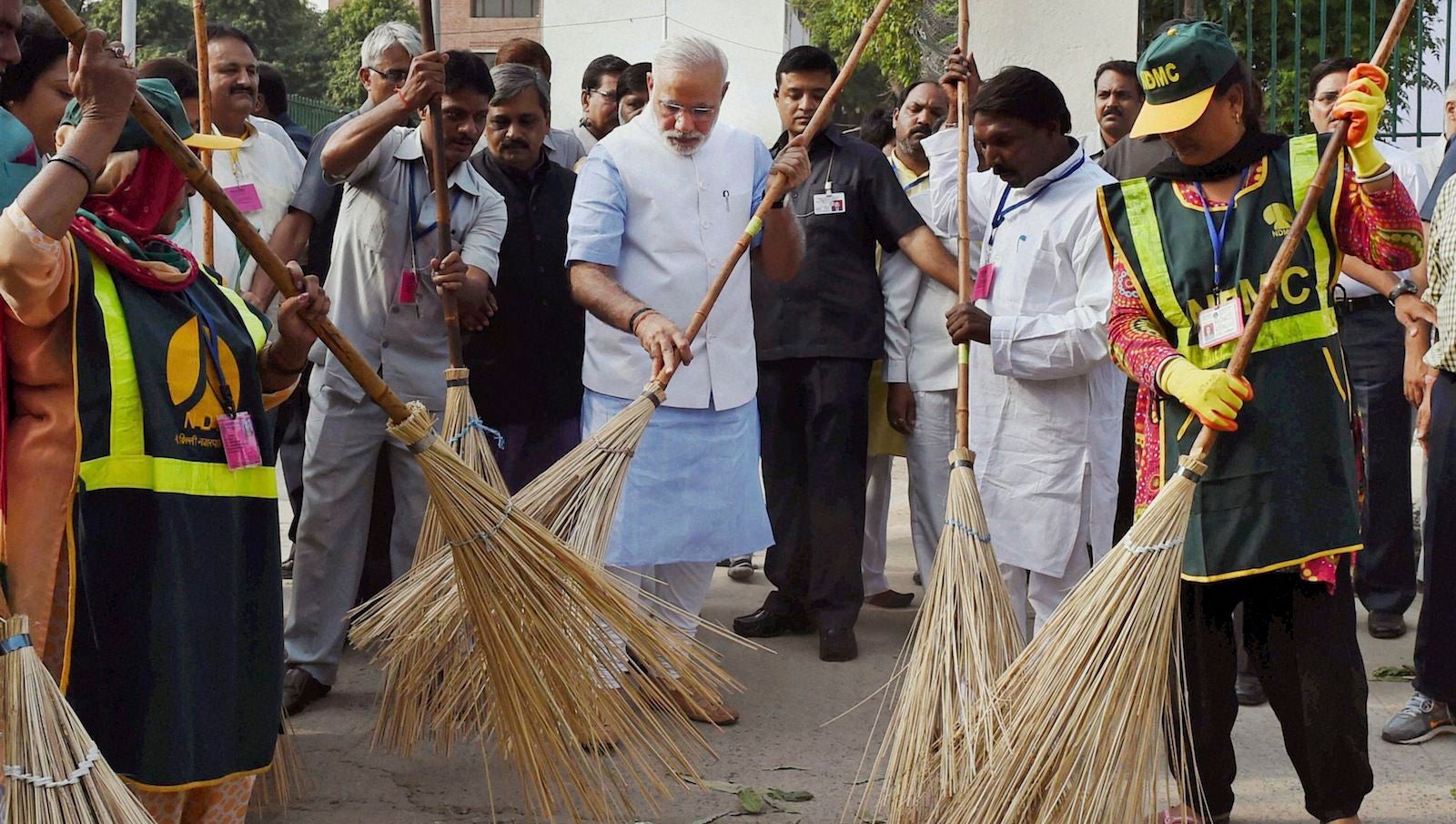Why Modi’s social media strategy to clean India is unlikely to go viral
Narendra Modi recently kicked off the “Swachh Bharat” or Clean India campaign. Needless to say, cleaning India’s public spaces is a mammoth project. To be realized within five years, the timeframe itself is a tacit acknowledgment of the mission’s complexity and enormity. And true to Modi’s reputation as a social media savant, the Clean India campaign is trying to leverage social networks to spread the message.


Narendra Modi recently kicked off the “Swachh Bharat” or Clean India campaign. Needless to say, cleaning India’s public spaces is a mammoth project. To be realized within five years, the timeframe itself is a tacit acknowledgment of the mission’s complexity and enormity. And true to Modi’s reputation as a social media savant, the Clean India campaign is trying to leverage social networks to spread the message.
Leave aside the inconvenient fact that only 200 million of 1.25 billion Indians are online—presumably those citizens who are not online will be targeted through offline channels. Here, let’s just focus on the efforts to involve the netizens of India. The playbook for the Clean India campaign is based on the ALS ice bucket challenge, which proved to be a social media blockbuster. Will #MyCleanIndia campaign become a viral hit like the ice bucket challenge?
Generating a viral hit is indeed the holy-grail pursuit of marketers. The tactics they use are not just trial-and-error. Viral marketing is a much-researched and carefully studied field these days. It is not an exact science (yet) but drawing from theories of psychology, online communication, social networking behaviours and more, key principles are being established to understand why some messages and ideas spread like wild fire while others fail to take off.
Modi prefers mnemonics (3Ds, 4Cs, 5Ts) to drive home his message. In similar fashion, here is a quick summary of viral marketing principles using 3Ms (Medium, Message, Messengers) and an assessment of whether the Clean India campaign in its current avatar can effectively exploit them.
Medium
For a campaign or an idea to spread rapidly, you rely on existing communication networks as much as possible. Think of this as “word of mouth” but on digital steroids.
In that respect, online social networks (and in India, Facebook) should be a no-brainer. You just post before and after videos or photos of a cleaning job and then invite (or tag) the others in your social graph to further spread it along the chain. In this respect, Modi (or his team) has done the right thing.
But where they get it wrong is in the number of friends to invite along the chain. More is not merrier—having to invite nine friends increases the cognitive effort on the user. Besides, the effect of social proof is diminished—you comply to a request if you see everyone else around you complying. In a group of nine, it is inevitable that a few won’t take it up—the burden of social expectation eases and the chain breaks.
Rather than nine invites, it’s a lot easier to invite two or three friends (who you know would not mind and will accept the challenge) and offers a greater chance of the chain continuing.
Messengers
Most people in a social network are passive consumers of information. But there are certain influential users who can shape opinion and drive adoption. They also generally tend to have a large number of followers who look up to them for signals. A viral marketer starts by identifying these influencers and brings them on-board.
The seed team of influencers for Clean India is drawn from diverse fields—entertainment (Priyanka Chopra, Salman Khan, the team of the TV series Taarak Mehta Ka Ooltah Chashmah and Kamal Haasan), politics (Shashi Tharoor, Goa governor and ex-BJP women’s wing president Mridula Sinha), sports (Sachin Tendulkar), business (Anil Ambani) and spirituality (Baba Ramdev).
It’s a good list—public figures with brand-name recognition and with social networks that do not have much of an overlap. My only quibble here is that some of them are not exactly active online users. And they are all mostly “uncles” and “aunts” from the point of view of young people on social media. Younger icons are missing in this list. But overall, it’s a good seed team of influencers (an A-minus, rather than an A-plus) and presumably others missing in the first round are likely to be roped in to do their bit.
Message
People are more likely to share or forward messages that have these characteristics—emotionally appealing, make them feel good, are exciting or fun and increase their social standing. If you wondered why the ice bucket challenge flooded your Facebook timeline, you now know why—it checks off all these criteria.
Cleaning a dirty place and then posting about definitely gives you bragging rights—it ups your social standing and makes you feel good. But unfortunately (for factors beyond anyone’s control), cleaning is not intrinsically fun or cool. This reduces its viral potential—unless there’s a fun twist or spin to the whole cleaning process.
Bottom line
The Clean India social media campaign means well, but it is likely to end up being a “nice try”. Even in terms of social media activity, it asks for a lot from the user and is also not much fun.
There will be initial spurts of activity but as currently envisioned, it is unlikely to approach the success of the ice bucket challenge.